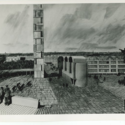Fifty years Churchill College Cambridge opened. Unlike the historic colleges, with their gothic buildings and medieval neoclassical parked behind high walls, it was in an almost rural setting on the outskirts of the city, the modern brutalism and detail design.
Competition 1959, which led the College to be is considered by many as a turning point in British war architectural history. It gathered 20 names, young and old, all practicing in Britain, all working in the modernist and more specifically the emerging brutalist style. It was a "who's who" of British architecture at the time, including Smithson, of Hungarian Erno Goldfinger, Lasdun (then in partnership with Maxwell Fry, Jane Drew & Lindsay Drake and former Russian emigre Lubetkin ), Lyons Israel Ellis and Robert Matthew (half of the team Royal Festival hall, who teamed with Johnson Marshall). None of these made the list of four.



 19
19
A moment watershed
at the Churchill competition, Britain had been very slow to embrace modern European continent. While 1934 book FRSYorke the building industry and therefore wider application of modernism beyond the designs for the houses "Modern House" testified to its existence in the British Isles, the Second World War and the severe shortages building materials that continued into the 1950s arrested, education and health care. Churchill has provided a stage for this new architecture, and many of the participants continued to build not only at Oxford and Cambridge, but new universities of whole campus, such as the ziggurat Lasdun scheme at the University of East Anglia. What made the most poignant result was the rejection of one of the four finalists, Stirling and Gowan, whose regime has been mythologized for their later fame.
Churchill College, founded to commemorate the life of Sir Winston Churchill, was built on the outskirts of Cambridge; he was one of a handful of new Oxbridge colleges including St Catherine by Arne Jacobsen, New Hall Chamberlain Powell and Bon and by Fitzwilliam Lasdun. The mission was to accommodate 500 residents who represent the bulk of the building, a dining room, common rooms, auditorium, library, offices, master houses, the lodge guardian, as well as housing for married couples. The site of 42 acres was a piece of generally rectangular farmland bounded by roads on both sides. Basically, the plan was to eliminate and every step appears complete. Finally, it was to be a lasting monument to a great man who would stand for 500 years.
50 years later, Re-examination of proposals Churchill
To mark the 50 e anniversary of the opening of the last month College, Cambridge University Land Society (CULS) held a debate in London; they invited three practicing architects and writer - Alison Brooks, Patrick Lynch, 6A Architects and Elain Harwood - to present the work of the four finalists by a jury including (Long & Kentish and the widow of Sandy Wilson) architects and Spencer de Grey (a partner at Fosters who studied at Churchill), and academic Peter Carolin (Professor Emeritus of architecture at the University of Cambridge) and David Dunster (professor of architecture at the University of Liverpool). The protagonists were chosen for various reasons: for his knowledge of the Twentieth Century British Modernism and especially for his writings about Chamberlain Powell & Bon, Elain Harwood; to discuss the proposal Stirling and Gowan, Patrick Lynch, a graduate of Liverpool and Cambridge who recently collaborated with John McAslan to renovate Stirling Florey Building for Queens College Oxford; representing Howell, Killick & Partridge, Alison Brooks, who is currently working on an Exeter College, Oxford system; and talk about Richard Sheppard Robson and win the scheme partners 6A Architects, working on an addition to Churchill himself.
The proposed Chamberlain Powell and Bonn
In 1959, Chamberlain Powell and Bonn had just been appointed to design the New Hall College adjacent . Chamberlain intended to unite New Hall, Churchill, and a third new College, Fitzwilliam, around a new square in the heart of which would be held a campanile. The architectural language shows part of the lightness of their field sooner Golden Lane in London and the horizon of the barrel vault of their Barbican not yet undeveloped complex, also in London, but with none of its Brutalist quality. The point of view of design, produced by the architect / architectural illustrator well known Gordon Cullen, shows a large modern urban landscape populated by a number of monumental structures.
Of the four finalists, it is less well documented and apparently the least distinctive. However, if they had won, it is Cambridge - the "city" - which would have been the most affected. The plan would have created a major urban district and counterpoint to link downtown historic colleges, unlike the campus of the Autonomous College off the suburban street that we encounter today.
Proposed Howell Killick & Partridge
design Howell Killick & Partridge has two large interlocking being shaped horseshoe. Somewhat irregular in the plan, the regime seems at first glance, as Alison Brooks suggested, to be organic. The courts, which are separate grounds of a ditch, open to the west. The ground plane is established to describe the vault would have characterized much of the traffic. Further complexity is introduced by faceting facades. The two main spaces, lobby and library, mark the point where the two courses intersect. The nature of this place is revealed by the prospect, which shows, in the foreground, a man sitting under a tree reading and punting on the ditch. The view reveals a vista in the southern courtyard and the northern beach crescent, dramatized by the forms library feast roof and the room.
The scene is picturesque. He recalls the architecture of Nash, particularly the croissants around the Regent Park and London's skyline its most exotic work, the Brighton Pavilion inspired oriental offered. It had been built, it would have been a mixture of gothic baroque festive executed concrete instead of stone or stucco. Although he finished second in the original competition, the jury of the 21st century has been highly critical of Howell Killick & Partridge, due both to a number of functional gaps of the regime and their Expressionism too elaborate.
Proposed Stirling and Gowan
Not surprisingly, the night of CULS debate, although Stirling and Gowan scheme known - that appeared everywhere from the approval at the beginning of Colin Rowe in many subsequent publications, including 2012 'James Stirling revisionary modernist, Amanda Reeser Lawrence which enshrines one of the six chapters in the plan - was most keenly awaited.
The Plan creates a 180m x 180m courtyard framed by a 2-storey city wall high student residences above a dirt embankment. As architects described their competitive relationship: "The open, flat and rural site said that in the design of a group of buildings as a residential college, it was important to create an internal environment, private, closed and protected. "inside, the dining room, library and other spaces that gather are arranged in the four quadrants of the quad.
scheme Stirling & Gowan, although for a University College of Cambridge, wore the mark of a great house English Baroque campaign. Indeed, the article of Colin Rowe The Blenheim welfare state ", published shortly after the winning project was announced, the connections between Blenheim Palace of John Vanbrugh, coincidentally the ancestral home of the Churchill family and the regime. By linking Stirling and Gowan architecture early to Vanbrugh, one of the great English architects, Rowe suggests that it is an appropriate model for college - that modernism is not only functionalism, but can also take advantage of the story. According to Rowe then, Stirling and Gowan's proposal better understand this story while suggesting an incredibly modern future. Its simple order and abstraction allowed him to serve these two masters apparently without compromise. In addition, it was both urban and rural, domestic and civic assembly for 500 years monument.
However, although the original jury described as "impressive", it is the perfect geometry and a large scale was not conducive to the progressive development that has been requested in the memory.
Richard Sheppard Robson's proposal and Partners
6A describes Richard Sheppard Robson and win the scheme partners through the prism of their own work: a still unbuilt residential yard for college, won a competition in the building of the autonomous court of 08. 6A extends the model plan for Sheppard, who has ten large and small interlocking being arranged in clusters around a mega court in which the primary buildings are arranged. The scheme is informal, parties are scrambling to form a whole. A three floors, it is relatively unobtrusive and certainly not manifestly ideological or technological. It is brutalist, forged intentionally oversized brick and concrete elements. It is mat, in the plan, attention to detail and generous in the way it frames the landscape in the courts and outside them.
interpreting 6A Sheppard (because that's what it is), the constant use of type and the incredible similarities dimensions allowed the architect to explore rich contrasts that future residents space and equipment will undoubtedly enjoy.
One world, an opportunity, Lost
The evening provided a window into a lost world, an age boundless optimism. He also offered an overview of the work of three practices whose work is largely forgotten. The words of Lynch highlighted the lost opportunity was the Stirling and Gowan system. The Blenheim welfare state might like Leicester illustrates beautifully, have matured together a humble and somewhat crude drawing in a large work. Similarly Chamberlain's ideas could, in the establishment of a strong urban location, prevented suburbanization Cambridge fringes of the city. And the pattern of Howell Killick & Partridge, who was a close second, would have given us a delirious modernism rooted in Englishness on a scale not seen since the wood in Bath and Nash in London - an opportunity that was then evaded practice can -being in part because of early deaths of both Howell and Killick. In the end it was the attention to the brief and insightful application of the tradition in mimicking the pattern of the court that brought victory to Richard Sheppard Robson and Partners. But one can not help thinking that the result, in its concern to retail in its many forms, was somewhat shabby - a lost opportunity
Simon Henley is a teacher, author of well-received architectural spaces, and co-founder of the studio based in London Henley Halebrown Rorrison (HHBR). His column, London Calling, look everyday reality of London's architectural culture and its role as a global architecture center; Above all, it will examine how London influences the design everywhere, while still being challenged from within. You can follow @SiHenleyHHbR and be a fan of his Facebook page, HHBR architecture.
Posting Komentar